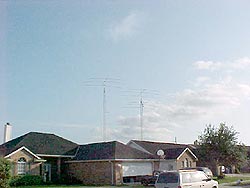Laisez les bon temps rouler!
(Let the good times roll)
You never really know how a contest is going to turn out. After years of increasing activity, last year’s RTTY Roundup declined somewhat. So as I sat watching the clock on the PC’s monitor, waiting for 1800Z, I was wondering what this year would hold in store for hundreds of RTTY operators around the world including me.
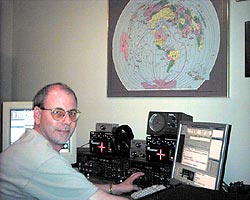
Last year I did my best to try to get more people interested in RTTY. I built up the RTTY page on my website and put more work into my WriteLog RTTY website as well.
When Ed, P5/4L4FN, started working exclusively RTTY, I decided to offer my nearly 20 years of RTTY experience to anyone that wanted help getting started on RTTY in hopes of working North Korea. I sent an E-mail to the DX reflector offering my services. I was not prepared for the response. It was overwhelming. In the first week, I received over 50 requests for help to get started on RTTY. I realized I would not be able to fulfill all these requests individually, so I decided to write a tutorial and place it on my website. It is called “Getting Started on RTTY”. I began working on the pages in late June and finished 10 days into July. In the week I announced the completion of the tutorial it took nearly 500 hits.
It appeared a lot of operators were taking advantage of the opportunity to get on RTTY. When it came to September and the CQ/RJ World Wide RTTY contest, I again made a big push, via the reflectors, to get more people on RTTY in hopes of having higher activity in the contest. That month the tutorial took 559 hits and many new stations appeared in the contest. In December I made yet another big effort to get more operators on RTTY. It resulted in my AA5AU RTTY Page taking over 2000 hits in the first 3 days of January alone – just in time for the Roundup. My WriteLog RTTY Website (now named rttycontesting.com) took over 200 hits on Friday, January 3rd, its most active day since September. It appeared that perhaps my efforts might pay off and stimulate participation in the Roundup. I sure hoped it would.
So as I watched the minutes, then seconds count down to the start of the contest, I was anxious with anticipation. How would this year’s contest fare? The propagation numbers were not nearly as good as they were in past years. With the solar flux at 138, the A index at 12 and the K at 2, I was concerned that propagation would be flat, yet the numbers weren’t terribly bad. Other than the A being a little high for my liking, I was content to just go out and have a good time. Whatever happens, I was going to have fun regardless of the propagation. And having fun is the ultimate reason we contest in the first place, right?
In an effort to keep Murphy at bay, in the weeks before the contest, I made sure the station was sound. I tried to make sure I had a spare of just about everything in case I had equipment failure. I had three spare power supplies. I had spare TNC’s. I had a spare radio. I even had a spare computer set up with WriteLog, my contesting software of choice, on-line and connected to my network and ready to go in case one of my other two computers failed. I tried to think of anything that might fail and what I would do if it did.
With a few seconds to go, in the final minute before the start, I sat there confident I would pass a good time (a Louisiana expression for having fun). When 1800Z hit, I was ready to go. Running SO2R (single operator, 2 radios), I started by alternating CQ’s on 10 and 15 meters. 90 seconds into the contest I was in a state of panic. 90 seconds and no QSO’s in the log! I checked to make sure I had power coming out each radio. The wattmeters showed that I did. What was the problem? I decided to continue CQ’ing on 15 meters and go S&P (search & pounce) on 10 meters. Finally the calls started coming in. I realized there was no problem and tried to relax. EA7FST called me on 15 meters for my first contact. Then all of a sudden the floodgates opened and the calls were coming 2, 3 and 4 at a time on 15 meters. I found big signals on 10 as I tuned across the band. Things were now heating up fast. Familiar callsigns flashed across the screens – W0DC, K3FH, N2WK, K6LL, F6AUS, W4GKM, K1US and WD9GMK. I snagged North Dakota with NW0L and found my good friend George, W1ZT on 10. These are all stations I’d worked countless times in years past. I had that warm fuzzy feeling again. Working the ARRL RTTY Roundup is like coming home. At 1807Z I did something I’ve never done before. I logged 5 QSO’s in a single minute. Laisez les bon temps rouler!
Twelve minutes into the contest a big signal parks right on top of my 15 meter run frequency and I am forced to move. This is not uncommon when running low power but I was hoping it wouldn’t happen this soon. Without the muscle to hold a frequency, it’s always wise to move. It’s too difficult to make contacts with someone blasting away, taking out your ability to receive. Losing precious time and contacts trying to fight a battle most likely lost is not smart contesting. Before I moved on 15, I found the nearest clear frequency on 10 and sent “QRL?” to see if anyone was using the frequency, then started calling CQ. I immediately got responses on 10 and I moved up the band on 15 and found a clear spot there. I called CQ on 15 and suddenly I had pileups on both radios. This flurry of activity helped get me into a rhythm early. Within 20 minutes after the start, I was in that zone where everything clicks, everything works and all is well with the world. No cares, no worries, just RTTY contesting euphoria. Getting a good start is crucial to the success of any serious contest effort.
YV5AAX called in for a nice multiplier. I get WB0ULX in SD, VE9FX in NB and find VE1OP in NS. K9NS calls in with a huge signal. I find VE5SF in SK and KI1G in RI on 15. Then Rick calls me on 10 for back-to-back contacts and WG7Y calls in from WY. I find AJ3M in DC; get called by WA1TTL in VT and N5PU in MS. All of these are excellent multipliers and in the first hour I log 106 contacts and 44 multipliers. Not only is this the best single hour rate for me in a Roundup, it’s my best single hour ever running low power in any RTTY contest dating back over 18 years.
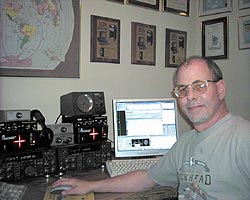 Things would slow only slightly the second hour with 92 QSO’s including nice multipliers from EI4DW, VE4COZ, my friend Mike WA0SXV in NM, VP5NN with a major signal, GI4KSH, GW4BLE, CO8ZZ, VY2SS and CN8KD. Good friends Jay WS7I, Steve N9CK, Mike K4GMH, Rick W4UEF, Doug N6TQS, Bill W9OL, May WA1EHK, Glenn VA3DX and Randy K5ZD are all logged and at 1942Z I move the 10-meter radio to 20 meters. I’m not sure why. It wasn’t planned. I just did it. Perhaps it was a natural instinct. I don’t know. But it ended up being a great move.
Things would slow only slightly the second hour with 92 QSO’s including nice multipliers from EI4DW, VE4COZ, my friend Mike WA0SXV in NM, VP5NN with a major signal, GI4KSH, GW4BLE, CO8ZZ, VY2SS and CN8KD. Good friends Jay WS7I, Steve N9CK, Mike K4GMH, Rick W4UEF, Doug N6TQS, Bill W9OL, May WA1EHK, Glenn VA3DX and Randy K5ZD are all logged and at 1942Z I move the 10-meter radio to 20 meters. I’m not sure why. It wasn’t planned. I just did it. Perhaps it was a natural instinct. I don’t know. But it ended up being a great move.
The third hour mirrored the first with 106 QSO’s. This marks yet another personal milestone for me. It’s the first time I ever log more than 100 contacts in two separate hours in the same contest. The move to 20 proves fruitful and the rate meter remains near 100/hr for the next couple of hours with only slight decreases. At one point, the short-term rate meter hits 226/hr for an 8-minute period. At this point I must have been nearly unconscious because I can’t remember much of the next few hours. It’s wall-to-wall RTTY signals on 15 and 20 meters. The multiplier board quickly fills up with the likes of CT2HZU, KS0M in MO, XE1YJS, WA4WXA in SC, PA0WRS, YU7AM, VO1HP in NF, DL9NEI, IV3HAX, K7VK in MT, 4Z4DX, KG8WB in WV, KM5FY in AR, YL7A, JM1LPN, S53MJ, CX7BY, LU6ETB, KL7FAA, KJ7TH in ID, 9A5W, OH8VJ, G3YBY, HK6DOS, K1IF in UT, 8P6SH, VK5GN, FK8HN, K0IDT in NE and KH6GMP. At 2336Z, I move the 15-meter radio to 40 meters and the rate jumps from 77 to 82/hr.
QSO rate is the measuring stick of all avid contesters. I had never run WriteLog’s rate meter for an entire contest before due to the lack of screen real estate. Because I had connected a spare computer to the network, I was able to display windows I normally do not show. Watching the rate meter got to be a lot of fun on the spare monitor. I worked hard trying to get it higher and maintain certain rates. I’d never contested like this before. It was new and exciting.
The move to 40 meters increased the rate again. But the move to 40 also is a critical stage of the contest for me. Transmitting on 40 can interfere with the 20-meter radio in certain situations. Under wet or damp conditions, I’ve not been able to operate 40 and 20 at the same time despite using bandpass filters, stubs or both. My antennas are just too close to each other. Being able to operate 40 and 20 at the same time is crucial. In 2001, I had dry conditions, but in 2002 it rained and I was forced to go from 20 to 80 when I moved from 15 to 40 on the other radio. Luckily, it hadn’t rained in southeast Louisiana for several days. Dry north winds had been blowing and everything was as dry as it gets around here. I had tested this band combination Friday and there was no RFI as long as I stayed high on 40 meters above 7075 kHz. Transmitting on 20 never affects receiving on 40 when using filters, but it’s not possible to transmit in the DX sub-band on 40, below 7050 kHz, without interfering with the 20-meter radio. To work multipliers on the lower end of 40, I will sacrifice a few seconds of RFI on 20. But to keep the rate going, it’s paramount that the interference not exist when transmitting on the high end of 40. I was lucky this year and for the next hour and a half, I successfully ran 20 and 40 meters while averaging an 85/hr rate. Although I picked up only two multipliers, OK2BXW and SV1BDO both on 40, it is rate that is important at stage of the contest.
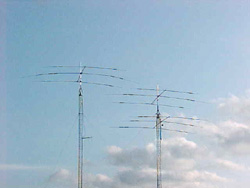 When the rate started to fall a bit on 20, I moved that radio to 80 meters at 0100Z. This was not a planned moved. It all depends on rate. The Roundup is a rate contest and when the rate starts to fall, it’s time to move to another band. When I got to 80 meters I was pleasantly surprised. The noise that is normally associated with this band was not present. There was no noise at all. And to top it off, there were loud RTTY signals everywhere! From 0100-0200Z, I once again topped the 100 QSO mark with 103 contacts logged on 40 and 80 meters. I am again amazed at the activity. The low bands are normally not thought of as highly productive RTTY bands but operation here is important to get the total QSO count up. So when you don’t slow down hitting the low bands, you have to smile and I did. 80 meters was very special that night. Just about everyone was loud. And if they weren’t loud, they were at least good print. I worked Europeans S54E, SP6EKS and HF70I as if they were locals. HK3DDD and HK3BZO called in. VP5NN (N6EE and W6XK) shows up with yet another huge signal. These guys are good. I watched them earlier on the high bands work through the pileup with amazing ease and they continued their dominating effort on 80. Forty meters proves to be excellent as well. TA1DX surprises me by calling in on 7091 kHz.
When the rate started to fall a bit on 20, I moved that radio to 80 meters at 0100Z. This was not a planned moved. It all depends on rate. The Roundup is a rate contest and when the rate starts to fall, it’s time to move to another band. When I got to 80 meters I was pleasantly surprised. The noise that is normally associated with this band was not present. There was no noise at all. And to top it off, there were loud RTTY signals everywhere! From 0100-0200Z, I once again topped the 100 QSO mark with 103 contacts logged on 40 and 80 meters. I am again amazed at the activity. The low bands are normally not thought of as highly productive RTTY bands but operation here is important to get the total QSO count up. So when you don’t slow down hitting the low bands, you have to smile and I did. 80 meters was very special that night. Just about everyone was loud. And if they weren’t loud, they were at least good print. I worked Europeans S54E, SP6EKS and HF70I as if they were locals. HK3DDD and HK3BZO called in. VP5NN (N6EE and W6XK) shows up with yet another huge signal. These guys are good. I watched them earlier on the high bands work through the pileup with amazing ease and they continued their dominating effort on 80. Forty meters proves to be excellent as well. TA1DX surprises me by calling in on 7091 kHz.
I worked the low bands hard for six hours and it was great fun but it had to end sometime. I had planned to go until 0700Z before I took my rest period. At 0615Z, the rate started to fall dramatically. I thought about quitting as early at 0630Z, but kept going. Then thought about it again at 0645Z, but I didn’t want to start my next session too early and the bands not be open at a 1245Z restart time. So I stayed with my plan and worked all the way to 0700Z despite logging only 41 contacts that last hour.
It was now time for rest. My plan was to take all six hours of rest in one period from 0701-1300Z. Experience tells me it’s the best thing to do. As fast-paced as this contest is, it’s best to get as much rest as possible at one time. Besides, it’s not likely a decent rate can be maintained between the hours of 0100 and 0700 local time. As I looked over my numbers, I was grinning ear to ear. I had 1082 QSO’s and 103 multipliers. Since they were considerably better than my 2001 numbers of 932 QSO’s and 99 multipliers for the same time period, I was cautiously optimistic. I turned off the radios and went to bed, feeling the affects of a cold I’d woken up with earlier that morning.
Despite a constant intake of Coca Cola and a number of BC Powders to ease my aches, I slept well that night and awoke at 1200Z. I immediately got up and made hot tea. With my chest congested and nose running, I didn’t feel as bad as I probably should have. I was excited and couldn’t wait to get started. In the shack I turned on all the gear and looked over the numbers once again. I checked WWV to see that the solar flux had risen to 143, the A remained at 12 and the K had dropped to 1. I saw this as a good sign. Since band conditions were pretty darn good on Saturday, it’s possible they could be even better on Sunday. I knew the flux was high enough to allow propagation into Europe on 10 meters from this part of the USA, so I was excited there just might be a possibility of beating my 2001 score. I was definitely going to give it my best shot.
At 1300Z I put my headphones on, placed one radio on 10 meters and the other radio on 15 meters. At 1301Z, I restarted the contest. There were no signals at all on 10 meters. This didn’t worry me greatly because it was barely sunrise so I moved that radio to 20 meters. On 15, I picked up LY2SA (a new multiplier) for my first contact then worked DJ3NG, DL9NEI, EA4AES and OK2SG in the first four minutes. I eventually settled on 21100 kHz and started running European stations. S&P on 20 meters produced only five stations in the first 14 minutes, yet one was LX5A for a new multiplier. So at 1315Z I switched back to 10 meters to find the band had started to open to Europe. Yes!
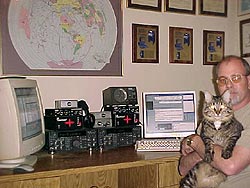 Ten meters was slow to open to Europe. I made only 13 QSO’s on 10 in the next 45 minutes, but my overall rate for that first hour after the break was 60 with 7 multipliers and I was pleased because I knew the high bands would open better later. The next hour would produce 72 contacts split evenly between 10 and 15 meters, as the European opening got better. 1500-1600Z produced 70 QSO’s, mostly Europeans. At 1615Z, my rate meter started to drop like a rock. Signals from Europe were fading on 10 meters. This was great cause for concern. I had hoped to work Europe up until at least 1700Z. US/VE stations were starting to come in now, which was good, but I made only 21 QSO’s in the first 21 minutes starting at 1600Z.
Ten meters was slow to open to Europe. I made only 13 QSO’s on 10 in the next 45 minutes, but my overall rate for that first hour after the break was 60 with 7 multipliers and I was pleased because I knew the high bands would open better later. The next hour would produce 72 contacts split evenly between 10 and 15 meters, as the European opening got better. 1500-1600Z produced 70 QSO’s, mostly Europeans. At 1615Z, my rate meter started to drop like a rock. Signals from Europe were fading on 10 meters. This was great cause for concern. I had hoped to work Europe up until at least 1700Z. US/VE stations were starting to come in now, which was good, but I made only 21 QSO’s in the first 21 minutes starting at 1600Z.
Then, out of nowhere, signals came pouring into my receivers at 1623Z. I started running pileups of mostly USA stations on both radios with an occasional European contact thrown in. In an instant, both 10 and 15 meters were wide open to North America – everywhere in North America. With both antennas at 20 degrees North, I worked station after station and got into that familiar groove. Once again, I was in the zone. My rate meter immediately shot up and I ended up with 78 QSO’s from 1600-1700Z. In the next hour I logged 84 stations. Then finally around 1800Z the rate started falling again. From 1800-1900Z I logged only 63 stations. Ten meters was slowly going away but I logged some nice multipliers on both bands – HP1AC, TG9/N0AT, EA8/DJ1OJ and GM4CXM. And at 1814Z I logged K3LT from DE on 10 meters for my last state! By 1900Z, I had 1509 QSO’s and 121 multipliers. I wanted to milk 10 meters for everything it had to offer, but I forced myself to go to 20 meters at 1910Z.
For the next two hours my rate would fall gradually to 58 and 51. This was not totally unexpected. I kept one radio on 15 while switching back and forth between 20 and 10 meters on the other radio. There were still plenty of stations to work. I just had to find them. These are typically slow periods for me. I understood this and it did not bother me. I was well ahead of pace and if I stayed steady, I would break my personal record. 2100-2200Z showed a slight increase of rate to 53. But 15-meter contacts were harder to come by. At 2120Z I made my 500th QSO on that band and immediately moved the radio to 40 meters. Twenty meters was starting to open up nicely. At 2133Z, A45WD called me for what would eventually be my 122nd and final multiplier. Then at 2210Z, I watch as my score goes over the 205,239-point mark, unofficially bypassing my 2001 score. I still had nearly two hours to go until the end. I was ecstatic!
For the last two hours I pounded 20 and 40 meters. My rate increased to 61 by 2300Z and I logged 65 stations in the final hour – whew! At 2359Z I worked K0THN in KS for my final contact and took off my headphones. It was over. Having operated all fourteen previous Roundups, I felt an immediate sense of pride that I was once again part of the best RTTY contest of year. I sat back and realized I’d had my best RTTY Roundup ever.
The numbers were staggering, 225 QSO’s on 80, 320 on 40, 445 on 20, 500 on 15 and 307 on 10 meters for a total of 1797 valid QSO’s and 122 multipliers with only 16 dupes. The unofficial score was 219,234 points. It marked several firsts for me; first time with 200 QSO’s on all five bands and 300 QSO’s on four bands in any contest. But the most incredible statistic of all was the average rate of 75 QSO’s/hr for the entire 24 hour contest period using low power. And all contacts were on RTTY.
The one thing that sticks out about this year’s RTTY Roundup is the high quality of operation by everyone who participated. Even the new guys got it right. I worked 102 new RTTY stations. The activity seemed to be at an all time high and there were still plenty of stations to work at the end. I have to thank my father, WB9FAD, for getting me into this wonderful hobby. He was the one that got me started on RTTY too. And thanks to Mr. Bill Bancroft, W9EDE, who was one of my Elmers when I was 14 years old. Thanks to the wonderful RTTY operators everywhere for the contacts. And thanks to the ARRL for sponsoring the greatest RTTY contest in world. I’ll be back next year. Wild alligators couldn’t keep me away. And as we say in Louisiana “Laisez les bon temps rouler!”
